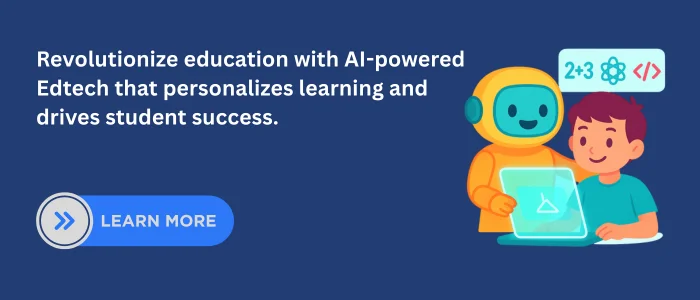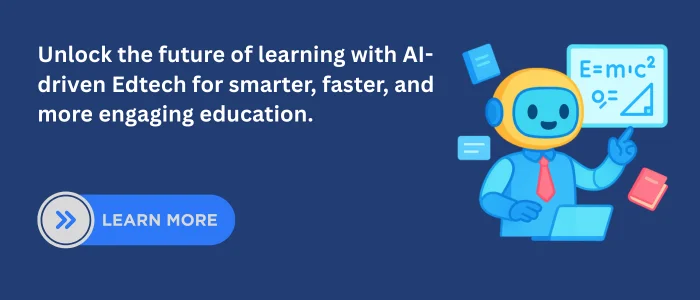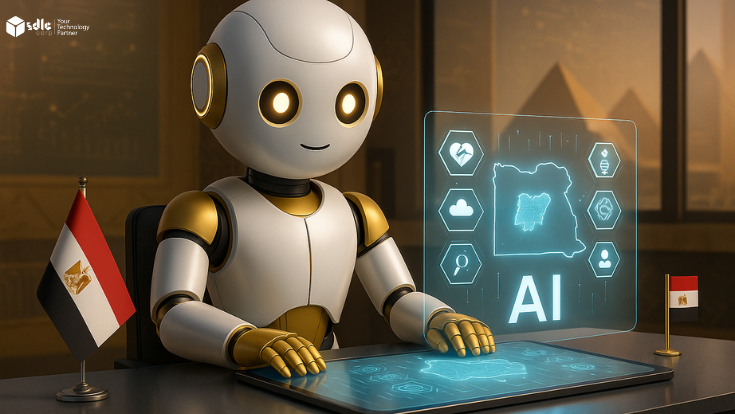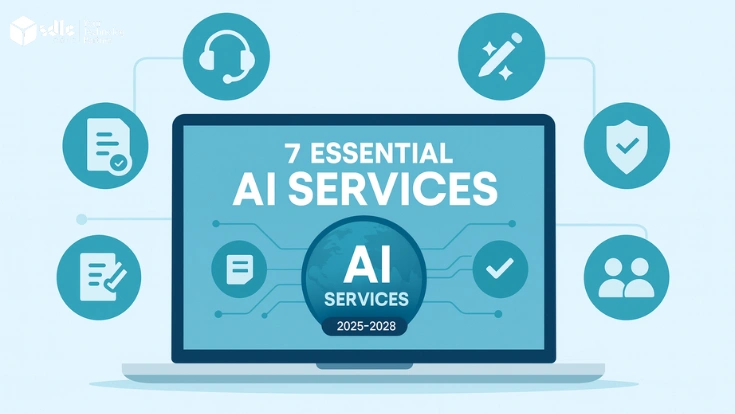Introduction
The rise of AI for EdTech marks the beginning of a transformative era in global education. Defined as the integration of artificial intelligence into educational technologies, it leverages data analytics, machine learning, and automation to create intelligent, adaptive, and personalized learning environments. With the support of AI development services and custom AI solutions, traditional classrooms are evolving into smart ecosystems where content dynamically adjusts to each learner’s needs.
This digital transformation accelerates the shift from passive learning to interactive, data-driven instruction. Recent studies show that the global AI for EdTech market is projected to surpass $30 billion by 2030, growing at a CAGR of over 35%, as schools and universities increasingly adopt AI-based learning systems. With capabilities such as predictive analytics, automated assessments, and virtual tutors, AI for EdTech not only enhances academic efficiency but also redefines the future of personalized, inclusive, and lifelong learning.
1.The Evolution of AI in Education Technology
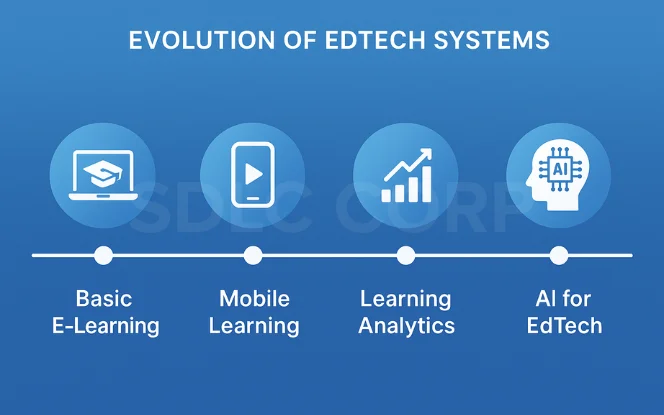
The transformation of education through AI for EdTech represents a defining moment in digital learning. From static e-learning modules to intelligent, data-driven ecosystems, the journey showcases how artificial intelligence revolutionizes the way learners engage with content. In the early 2000s, digital education platforms focused primarily on content delivery and basic interaction. However, as technology evolved, AI for EdTech began incorporating automation, analytics, and adaptive intelligence to personalize and enhance learning efficiency.
Historical Overview: From E-Learning to AI for EdTech Ecosystems
Between 2000 and 2010, the rise of e-learning marked the first major shift in digital education. Platforms provided accessibility but lacked adaptability. As a result, learners received identical materials regardless of skill or progress. With the integration of machine learning and analytics in the following decade, AI for EdTech introduced adaptive systems capable of identifying patterns and predicting learner needs. By 2020, these technologies had matured into intelligent EdTech ecosystems that continuously evolve based on user data.
Influence of Machine Learning, Automation, and Analytics
Machine learning algorithms now analyze massive data sets to personalize instruction in real time. Automation reduces administrative workloads, allowing educators to focus on creative teaching. Moreover, analytics in AI for EdTech transforms passive learning into a responsive, evidence-based process. These advancements collectively enhance engagement, retention, and academic outcomes.
| Period | Educational Shift | AI Contribution |
|---|---|---|
| 2000–2010 | Rise of e-learning | Data-driven content delivery |
| 2010–2020 | Adaptive learning | Predictive models for students |
| 2020–Present | Intelligent EdTech | Full integration of AI for EdTech |
Since 2020, AI for EdTech has achieved full ecosystem integration—bridging human cognition with algorithmic intelligence to create smarter, scalable education models. To explore deeper technical insights, visit How Machine Learning Shapes Digital Learning Tools, where the role of machine learning in AI for EdTech is examined in greater detail.
2. Core Technologies Powering AI for EdTech
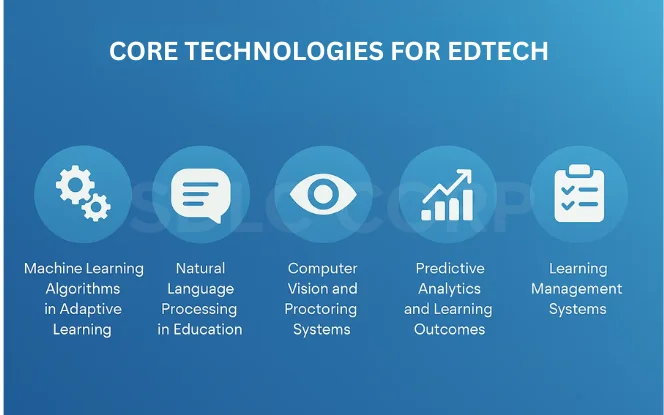
Artificial Intelligence has become the cornerstone of digital transformation in the financial sector. AI for Fintech enhances security, decision-making, and personalization, empowering institutions to deliver faster, smarter, and more secure services. Below are the most impactful applications shaping the Fintech landscape.
Machine Learning Algorithms in Adaptive Learning
Machine learning stands at the foundation of AI for EdTech. Through continuous data analysis, it detects learning behaviors and dynamically adjusts instructional paths. Therefore, AI for EdTech uses ML-based recommendation engines that assess engagement, test performance, and pace to personalize content delivery. Additionally, behavioral data analytics provide educators with real-time feedback on learner progress.
- Adaptive Curriculum Optimization: ML algorithms within AI for EdTech analyze comprehension data to recalibrate learning difficulty.
- Personalized Recommendation Engines: Systems suggest relevant lessons, ensuring each learner follows a unique path.
- Example: Knewton Alta employs ML to deliver precision-based adaptive content.
As a result, learners experience customized education that evolves with every interaction, while educators gain deeper insights into student performance.
Natural Language Processing in Education
Natural Language Processing (NLP) strengthens AI for EdTech by allowing systems to understand and respond to human language. Consequently, AI chatbots and virtual assistants provide immediate answers, feedback, and guidance, enhancing accessibility. Furthermore, automated grading systems analyze syntax, semantics, and tone to evaluate essays objectively.
- AI-Powered Essay Evaluation: NLP tools like Grammarly EDU score grammar, structure, and clarity.
- Automated Feedback Generation: NLP models summarize key points and provide personalized writing tips.
- 24/7 Chat Support: AI for EdTech chatbots assist learners beyond classroom hours.
Hence, NLP bridges communication gaps between digital systems and human learners, improving engagement, precision, and productivity simultaneously.
Understanding About What is NLP Invoices Processing?
Computer Vision and Proctoring Systems
Computer Vision (CV) plays a crucial role in AI for EdTech, particularly in assessment security and engagement monitoring. Through gesture recognition, facial analysis, and gaze tracking, AI for EdTech ensures integrity during online examinations. Moreover, CV technologies measure emotional responses and concentration levels to refine instructional delivery.
- Smart Proctoring Systems: ExamSoft AI monitors activity to maintain exam fairness.
- Gesture Recognition: Real-time detection prevents dishonest behavior.
- Behavior Analytics: CV tools assess focus, allowing instructors to adjust learning methods.
Consequently, institutions benefit from transparent, secure, and fair evaluations while maintaining student trust.
Read About : Vision-Language Models (VLMs)
Predictive Analytics and Learning Outcomes
Predictive analytics within AI for EdTech transforms raw educational data into actionable intelligence. As a result, it predicts student outcomes, identifies at-risk learners, and enables early interventions. Furthermore, AI dashboards visualize trends, empowering teachers to make data-driven decisions.
- Performance Forecasting: Tools like Coursera AI Dashboard analyze participation and assignment data.
- At-Risk Identification: Predictive models flag learners who need additional support.
- Outcome Optimization: Insights drive personalized mentorship and content refinement.
Therefore, predictive analytics ensures proactive academic support and enhances overall learning success.
Ultimately, AI for EdTech unites these technologies into an intelligent educational framework. Consequently, learners benefit from continuous adaptation, educators gain operational efficiency, and institutions achieve measurable improvement. Therefore, the synergy of ML, NLP, CV, and predictive analytics propels AI for EdTech into a new dimension of smart, responsive, and transformative learning.
3. Applications of AI for EdTech in Real Learning Environments
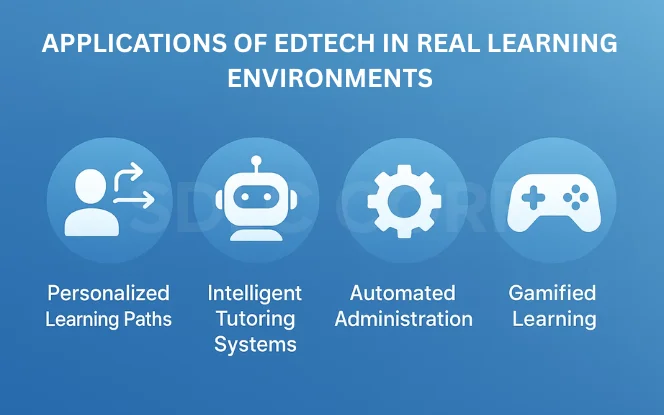
The adoption of AI for EdTech across schools, universities, and corporate training programs demonstrates how artificial intelligence revolutionizes real-world education. Through personalized systems, intelligent tutoring, automation, and gamification, AI for EdTech transforms static learning experiences into dynamic, data-driven interactions. These innovations empower learners with individualized pathways, improve teacher efficiency, and create adaptive ecosystems that continuously evolve with user behavior.
Personalized Learning Paths
One of the most impactful applications of AI for EdTech lies in personalized learning. By analyzing cognitive patterns, behavioral data, and performance metrics, AI for EdTech tailors course materials to each student’s learning style and pace. Machine learning algorithms recommend resources, adjust complexity, and identify areas requiring reinforcement.
- Dynamic Curriculum Design: AI for EdTech modifies content flow in real time based on learner responses.
- Predictive Personalization: Systems forecast progress and adapt lessons accordingly.
- Example: Duolingo’s adaptive algorithm continuously analyzes user accuracy and adjusts exercises to optimize retention.
Therefore, AI for EdTech ensures that each learner experiences a unique and engaging journey aligned with their strengths and challenges.
Intelligent Tutoring Systems
AI for EdTech introduces intelligent tutoring systems (ITS) that simulate human-like mentorship. These systems use natural language processing and emotional recognition to provide real-time feedback and guidance. Virtual mentors and chatbots within AI for EdTech environments assist students 24/7, clarifying doubts and enhancing motivation.
- Emotion-Aware Systems: Detect frustration or confusion and modify teaching tone.
- AI Chatbots: Provide instant feedback and contextual support.
- Virtual Mentors: Offer personalized recommendations for deeper understanding.
Consequently, learners benefit from continuous, adaptive support that mirrors human empathy while maintaining computational precision.
Automated Administration
Automation is another core strength of AI for EdTech, simplifying administrative and operational workloads. Intelligent systems manage attendance, grading, and progress tracking without manual intervention.
- Gradescope’s AI-Driven Grading: Automates assessments with high accuracy and objectivity.
- AI-Based Attendance Tracking: Uses facial recognition and predictive analytics for attendance forecasting.
- Google Classroom Analytics: Provides actionable insights into learner engagement and participation.
Hence, AI for EdTech minimizes repetitive tasks, freeing educators to focus on creativity and student engagement rather than logistics.
Learn More : Workflow Automation Services
Gamified Learning
Gamification powered by AI for EdTech enhances motivation and engagement through adaptive challenges and real-time rewards. By analyzing user data, systems calibrate difficulty, provide instant feedback, and reward milestones to sustain interest.
- Adaptive Game Mechanics: AI adjusts difficulty according to user skill levels.
- Behavioral Insights: Predictive models personalize challenges based on performance history.
- AI-Driven Feedback Loops: Keep learners engaged through progressive reinforcement.
As a result, AI for EdTech transforms traditional instruction into an interactive, motivational experience that boosts retention and participation. Explore deeper insights in Gamification in EdTech: Data-Driven Motivation to understand how analytics-driven design enhances engagement through AI for EdTech principles.
Checkout : AI for Gaming
4. Benefits of AI for EdTech Across Stakeholders
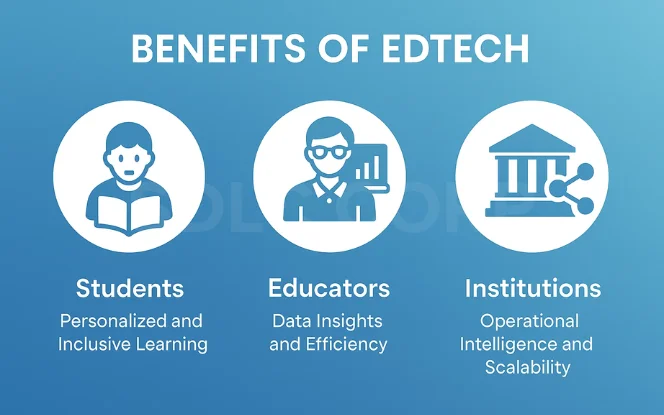
The integration of AI for EdTech generates significant advantages for every stakeholder in the education ecosystem from students and educators to administrators and institutions. By merging automation, analytics, and intelligent algorithms, AI for EdTech creates learning environments that are more adaptive, data-driven, and efficient. Through personalization, accessibility, and insight generation, it ensures measurable improvements in engagement, comprehension, and operational performance.
Educators: Data Insights and Efficiency
Educators experience one of the greatest transformations through AI for EdTech. Automated grading, attendance tracking, and lesson planning reduce manual workloads while predictive analytics identify at-risk students early. Furthermore, AI for EdTech enables teachers to access real-time dashboards that visualize learning trends and behavioral insights.
- Automated Evaluation: Objective grading enhances fairness and consistency.
- Predictive Intervention: Systems identify struggling learners before performance declines.
- Enhanced Engagement: Personalized teaching strategies improve classroom participation.
Hence, AI for EdTech allows teachers to shift focus from repetitive tasks to creative instruction and mentoring.
Institutions: Operational Intelligence and Scalability
For institutions, AI for EdTech optimizes operations, resource allocation, and strategic planning. Data-driven systems streamline enrollment, scheduling, and reporting, creating measurable efficiency gains.
- Enrollment Optimization: AI predicts student demand and manages admissions dynamically.
- Analytics Dashboards: Administrators gain insights into performance, engagement, and retention.
- Outcome Enhancement: Institutions achieve higher success rates through informed decision-making.
Ultimately, AI for EdTech unifies students, educators, and institutions through a shared ecosystem of intelligence and automation. For further insights into how analytics strengthen this collaboration, explore Data Analytics in Modern Classrooms to understand how AI for EdTech drives data-informed academic excellence.
5. Ethical and Data Security Challenges in AI for EdTech
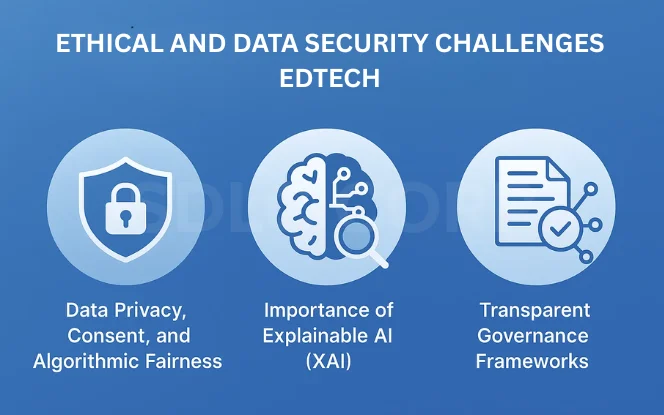
While AI for EdTech transforms education with intelligent automation and personalization, it also introduces complex ethical and data security challenges. As learning platforms collect vast amounts of personal data, ensuring privacy, fairness, and transparency becomes essential. The rapid expansion of AI for EdTech highlights the need for robust governance structures that protect students and educators while maintaining the integrity of educational systems.
Data Privacy, Consent, and Algorithmic Fairness
AI use in education raises questions around fairness, data privacy, and transparency. Governance frameworks help ensure ethical use and regulatory compliance. An AI consulting company may assist EdTech providers in defining policies, oversight mechanisms, and evaluation criteria.
In AI for EdTech environments, large-scale data collection enables adaptive learning but also raises privacy concerns. Student information such as behavior logs, performance metrics, and emotional data must be processed with explicit consent and strong encryption. Furthermore, algorithmic bias can lead to unfair assessments if data sets lack diversity. Therefore, AI for EdTech systems require rigorous auditing and ethical data sourcing to ensure equitable outcomes for all learners.
- Informed Consent: Learners and guardians must understand how data is collected and used.
- Data Protection: Encryption and anonymization prevent unauthorized access.
- Bias Mitigation: Balanced and diverse training data uphold fairness in AI for EdTech algorithms.
Importance of Explainable AI (XAI)
Explainable AI (XAI) plays a vital role in maintaining trust within AI for EdTech platforms. Transparent systems allow educators and students to understand how decisions such as grading or content recommendations are made. Consequently, XAI improves accountability, reduces skepticism, and enhances ethical compliance.
Transparent Governance Frameworks
Educational institutions adopting AI for EdTech must implement governance models that define ethical boundaries and compliance standards. Clear data-handling protocols, regular system audits, and stakeholder oversight help maintain integrity and build public confidence in intelligent learning systems.
Explore More : AI for Government
| Ethical Issue | Risk | Mitigation |
|---|---|---|
| Data bias | Unfair assessments | Regular audits |
| Privacy breaches | Data exposure | Encryption & anonymization |
| Lack of transparency | Loss of trust | Explainable AI mode |
Ultimately, developing ethical, secure, and transparent AI for EdTech ecosystems ensures technology serves learners responsibly balancing innovation with accountability and trust.
6. Future Trends of AI for EdTech
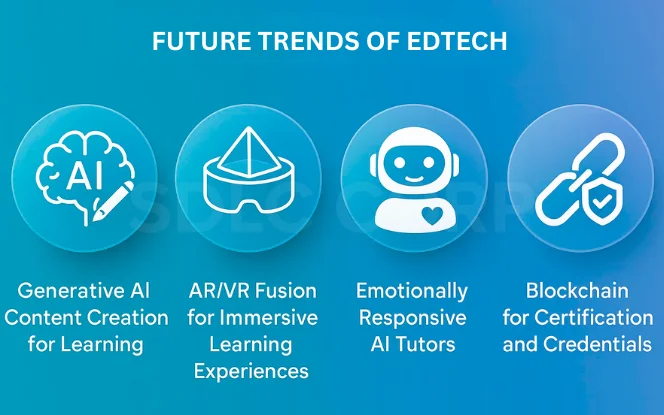
The future of AI for EdTech is rapidly unfolding, driven by breakthroughs in generative intelligence, immersive technologies, and data integrity systems. As the educational landscape becomes more digital, AI for EdTech continues to evolve from predictive analytics toward fully autonomous, interactive, and emotionally intelligent systems. These innovations promise to redefine how learners interact with content, educators deliver instruction, and institutions manage academic ecosystems.
Generative AI Content Creation for Learning
Generative models in AI for EdTech will automate the creation of instructional materials, assessments, and interactive simulations. By analyzing curriculum requirements and learner behavior, generative AI can produce customized lessons, quizzes, and visuals in seconds. This automation not only saves time but also ensures that educational content remains relevant, updated, and tailored to individual needs.
AR/VR Fusion for Immersive Learning Experiences
The integration of augmented reality (AR) and virtual reality (VR) within AI for EdTech will deliver immersive and experiential learning. Through AI-powered spatial recognition and adaptive guidance, students will explore complex subjects in simulated environments. As a result, learners will visualize abstract concepts and engage through multisensory interaction, significantly enhancing comprehension and retention.
Emotionally Responsive AI Tutors
Next-generation AI for EdTech systems will feature emotionally aware tutors capable of interpreting facial cues, tone, and engagement levels. These AI tutors will adjust their communication style, motivation strategy, and content delivery in real time—replicating empathetic human teaching behavior. Consequently, education becomes more personalized, emotionally supportive, and effective.
Blockchain for Certification and Credentials
Blockchain integration in AI for EdTech ensures secure, tamper-proof academic credentialing. Certificates, transcripts, and digital badges stored on decentralized ledgers enhance transparency and trust in educational validation. Institutions adopting this approach can verify achievements instantly while reducing fraud.
As these advancements converge, AI for EdTech is set to transform lifelong learning into a fully intelligent, secure, and human-centered experience. Explore more in Emerging Trends in Artificial Intelligence 2025 to understand how these technologies will redefine global education.
7. Implementation Strategies and Best Practices for AI for EdTech
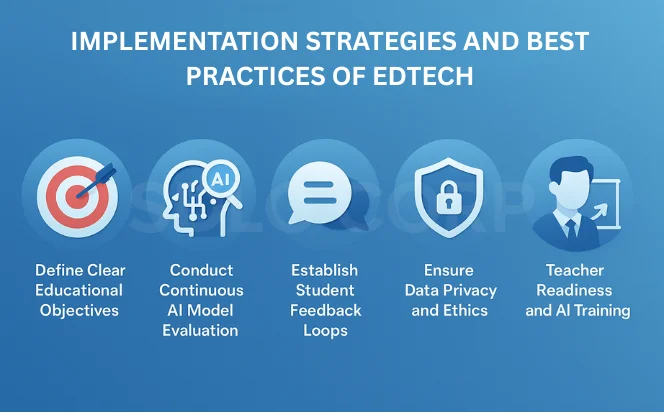
Successful adoption of AI in EdTech requires a structured and ethical approach that ensures both educational effectiveness and technological integrity. Institutions should prioritize careful planning, robust data management, and continuous model improvement to maximize the potential of intelligent learning systems.
Finally, teacher readiness is essential. Continuous training enables educators to understand AI behavior, interpret analytics responsibly, and uphold ethical standards, while transparency in AI decisions builds confidence among instructors and learners.
Read More : Blockchain for Edtech: How Decentralized Systems are Changing the Education Landscape
Key Best Practices for Implementing AI for EdTech:
- Define Clear Educational Objectives: Align every AI for EdTech initiative with measurable learning outcomes.
- Conduct Continuous AI Model Evaluation: Regularly audit system performance to detect bias or drift.
- Establish Student Feedback Loops: Gather learner input to refine adaptive models.
- Ensure Data Privacy and Ethics: Uphold compliance with data governance and consent protocols.
By combining these best practices, institutions can implement AI for EdTech solutions that are effective, transparent, and sustainable—bridging technology with pedagogy in a responsible, future-ready manner.
8. Case Studies: Successful Use of AI for EdTech
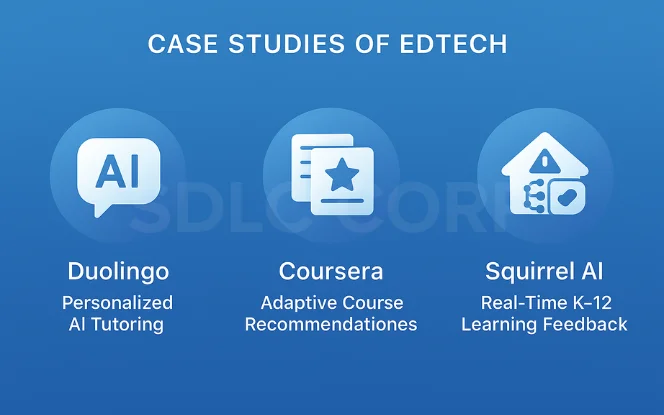
Real-world implementations of AI for EdTech highlight how intelligent technologies transform education through personalization, adaptability, and measurable impact. By integrating machine learning, natural language processing, and analytics, leading organizations are redefining the standards of digital education and student engagement.
Duolingo – Personalized AI Tutoring
Duolingo is a prime example of AI for EdTech innovation. The platform’s AI-driven algorithms personalize learning experiences by analyzing user proficiency, pacing, and response accuracy. Through adaptive exercises and real-time feedback, Duolingo continually adjusts content difficulty to suit individual learners. As a result, users demonstrate higher retention rates and improved long-term fluency.
Coursera – Adaptive Course Recommendations
Coursera leverages AI for EdTech to deliver adaptive course recommendations that align with learner behavior and preferences. Using predictive analytics, Coursera’s system suggests personalized learning paths, increasing engagement by nearly 30%. Furthermore, its AI-driven dashboards provide educators with insights to refine course delivery and improve completion rates.
Squirrel AI –Real-Time K–12 Learning Feedback
Squirrel AI represents one of the most advanced AI for EdTech implementations in K–12 education. Its adaptive learning engine continuously evaluates student performance and provides instant feedback. Teachers receive actionable insights that help them modify instruction and focus on individual learning gaps. Consequently, the system enhances both efficiency and academic outcomes.
Enterprise-Scale AI Platforms for Education Providers
Large education providers and institutions manage learning platforms across multiple programs and regions. Enterprise-scale AI platforms support centralized insights while allowing localized customization. Architectural practices used by an enterprise AI development company often inform how scalable EdTech systems are designed.
Conclusion
AI for EdTech is redefining global learning by merging intelligence, accessibility, and innovation. Through adaptive algorithms, predictive analytics, and automation, it enables personalized and equitable classrooms where every learner can thrive. With the help of AI development services, educational institutions can build scalable, data-driven systems that enhance engagement, efficiency, and inclusion.
The true potential of AI for EdTech lies in responsible innovation—balancing progress with ethics and transparency. By fostering trust, accountability, and continuous improvement, educators and EdTech leaders can shape a smarter, more inclusive future for learning. Explore more insights in our AI and EdTech Consulting Blog to lead this transformation responsibly.
FAQs
1. What is AI for EdTech and how does it work?
AI for EdTech integrates artificial intelligence with education technology to automate learning processes, personalize content, and enhance classroom experiences through machine learning, analytics, and adaptive algorithms.
2. How does AI for EdTech personalize student learning?
Using data analytics and behavioral modeling, AI for EdTech adjusts course materials, difficulty levels, and feedback to each learner’s pace and performance, ensuring customized and efficient learning outcomes.
3. What are the main benefits of AI for EdTech for teachers?
AI for EdTech supports teachers by automating grading, tracking student progress, and providing predictive insights that help educators focus more on creativity and personalized instruction.
4. Is AI for EdTech safe for handling student data?
Yes when implemented with encryption, anonymization, and ethical governance, AI for EdTech ensures data privacy and compliance with global education and data protection standards.
5. What are the emerging trends shaping AI for EdTech?
Future AI for EdTech innovations include generative content creation, emotion-aware tutoring, AR/VR-based immersive classrooms, and blockchain-powered certification systems for secure credential management.

